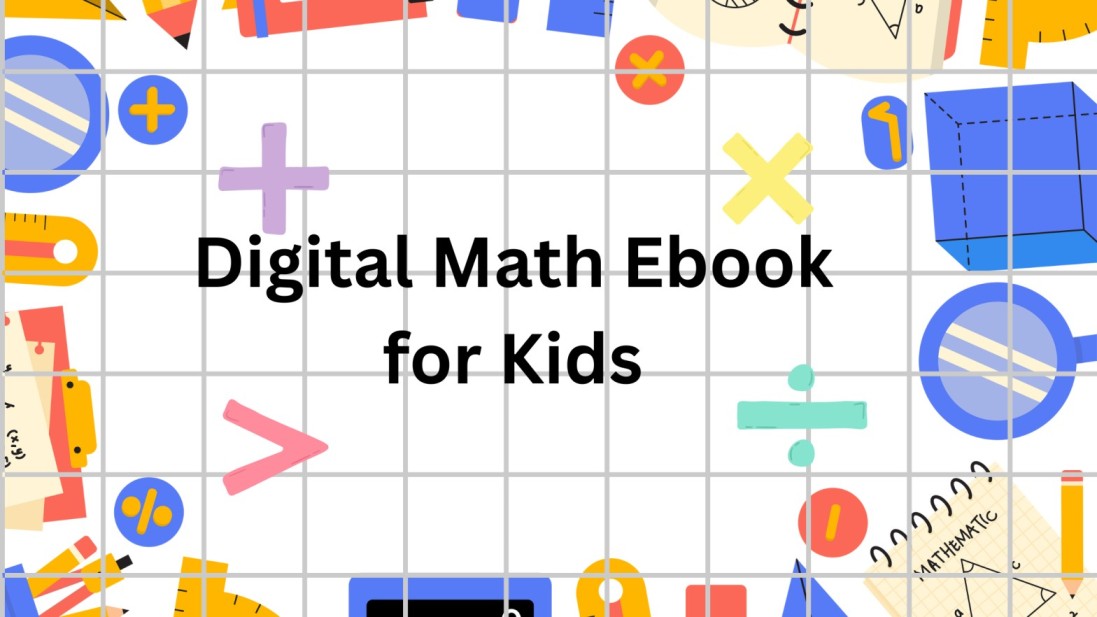Digital Math eBooks for Kids: Engaging Young Minds in the Digital Age
In today’s tech-savvy world, digital resources are revolutionizing how we approach education. One exciting development in this realm is the rise of digital math eBooks for kids. These interactive tools are transforming the traditional approach to learning math, making it more engaging and accessible than ever before. In this blog, we’ll explore the benefits of digital math eBooks, their key features, and how they fit into the broader landscape of digital learning.
1. Introduction to Digital eBooks
1.1 What Are Digital Math eBooks?
Digital math eBooks are electronic versions of traditional math textbooks, designed specifically for young learners. They come in formats that can be read on various devices such as tablets, smartphones, and computers. Unlike traditional print books, digital eBooks offer dynamic features such as interactive animations, quizzes, and multimedia content that bring math concepts to life.
Differences Between Traditional and Digital Formats:
| Feature | Traditional eBooks | Digital Math eBooks |
|---|---|---|
| Format | Print on paper | Electronic (PDF, ePub, app-based) |
| Interactivity | Static text and images | Interactive elements (animations, quizzes) |
| Accessibility | Fixed, non-adjustable | Adjustable text size, read-aloud options, high-contrast modes |
Accessibility Features of Digital eBooks:
Digital math eBooks often include features such as adjustable text size, read-aloud functions, and high-contrast modes to support diverse learning needs.
1.2 The Importance of Math in Early Education
Math is a cornerstone of early education, playing a crucial role in cognitive development. Understanding basic math concepts helps children develop problem-solving skills, logical reasoning, and critical thinking.
Real-World Applications:
Early math skills lay the groundwork for future academic and real-life success, including tasks like budgeting, measuring, and spatial awareness.
Long-Term Benefits:
Children who grasp math concepts early on often exhibit stronger academic performance throughout their schooling and in their future careers. Research from the National Institute for Early Education Research highlights that early math skills predict later academic achievement better than early reading skills (NIEER, 2023).
1.3 Overview of the Digital Learning Landscape
The digital learning landscape has seen remarkable growth, with an increasing number of educational tools transitioning from print to digital formats.
Growth of Digital Learning Tools:
Digital tools have become essential in modern education, offering interactive and adaptable resources that cater to various learning styles.
Trends in Children’s Educational Resources:
There is a noticeable shift towards incorporating technology into learning, driven by the need for more engaging and personalized educational experiences. According to a 2023 report by EdTech Magazine, 75% of K-12 teachers now use digital resources regularly in their classrooms.
2. Benefits of Digital Math eBooks for Kids
2.1 Interactive Learning Experiences
One of the most compelling benefits of digital math eBooks is their ability to provide interactive learning experiences.
Features That Promote Engagement:
Digital eBooks often include animations, interactive quizzes, and gamified elements that make learning math fun and engaging. For instance, a study by the Educational Technology Research and Development Journal found that interactive eBooks increase student engagement by up to 40% (ETRD, 2022).
Role of Gamification:
Gamification incorporates game-like elements such as rewards and levels to motivate children and enhance their learning experience.
Feedback Mechanisms:
Instant feedback helps children understand their mistakes and learn from them in real time, promoting a deeper understanding of math concepts.
2.2 Customization and Personalization
Digital math eBooks offer a high level of customization, catering to individual learning paces and styles.
Tailoring Content:
Content can be adjusted based on a child’s progress and comprehension, allowing for a personalized learning journey.
Options for Different Learning Styles:
Whether a child is a visual, auditory, or kinesthetic learner, digital eBooks can incorporate various multimedia elements to match their preferred learning style.
Progress Tracking and Adaptive Learning Paths:
Parents and educators can track a child’s progress and adapt the learning path to address areas of improvement.
2.3 Accessibility and Convenience
Digital math eBooks provide unmatched accessibility and convenience.
Availability on Various Devices:
Children can access eBooks on tablets, smartphones, or computers, making learning flexible and portable.
Benefits for Children with Learning Disabilities:
Digital eBooks often include features that support children with learning disabilities, such as text-to-speech and customizable text display. The National Center on Accessible Educational Materials reports that digital resources significantly enhance learning opportunities for students with disabilities (NCAEM, 2023).
Ease of Updating Content:
Unlike print books, digital eBooks can be updated easily, ensuring that children have access to the most current information and teaching methods.
3. Key Features of Effective Digital Math eBooks
3.1 Engaging Content and Design
For a digital math eBook to be effective, it must combine engaging content with appealing design.
Importance of Colorful Visuals and Illustrations:
Bright and engaging visuals help capture children’s attention and make abstract concepts more tangible.
Use of Storytelling:
Incorporating storytelling can make math concepts more relatable and enjoyable, enhancing the learning experience.
Balancing Educational Content with Entertainment:
Effective digital eBooks balance educational content with entertaining elements to maintain engagement without compromising learning.
3.2 Interactive Tools and Resources
Interactive tools are a hallmark of digital math eBooks.
Incorporation of Games and Puzzles:
Games and puzzles reinforce math skills and make learning enjoyable.
Use of Videos and Animations:
Multimedia elements like videos and animations help illustrate complex concepts in a more understandable way.
Availability of Worksheets and Practice Problems:
Digital eBooks often include practice problems and worksheets that allow children to apply what they’ve learned.
3.3 Assessment and Feedback Mechanisms
Assessments and feedback are integral to the learning process.
Types of Assessments:
Effective eBooks feature various types of assessments, including quizzes and interactive exercises, to evaluate understanding.
Importance of Instant Feedback:
Immediate feedback helps children correct mistakes and solidify their understanding of math concepts.
Tools for Parents and Teachers:
Features that allow parents and teachers to monitor progress and provide additional support are crucial for maximizing the effectiveness of digital math eBooks.
4. Choosing the Right Digital Math eBook
4.1 Age Appropriateness and Skill Level
Selecting the right digital math eBook involves considering the child’s age and skill level.
Guidelines for Selecting eBooks:
Choose eBooks that align with the child’s age and developmental stage, ensuring the content is both age-appropriate and challenging.
Assessing Content Difficulty:
Evaluate the difficulty level of the content to match the child’s current math abilities.
Aligning with Curriculum Standards:
Ensure the eBook aligns with educational standards and curriculum goals.
4.2 Reviews and Recommendations
Finding a high-quality digital math eBook requires research.
How to Find Credible Reviews:
Look for reviews from reputable sources and educational experts. Websites like Common Sense Media offer comprehensive reviews and ratings for educational apps and eBooks.
Importance of Recommendations from Educators:
Recommendations from teachers and educators can provide valuable insights into the eBook’s effectiveness.
Exploring User Testimonials:
Reading user testimonials can help gauge the eBook’s suitability and effectiveness from a parent’s or child’s perspective. For example, EdSurge features reviews and insights into various educational technologies.
4.3 Trial and Subscription Options
Many digital math eBooks offer trial and subscription options.
Benefits of Free Trials and Sample Chapters:
Free trials and sample chapters allow you to evaluate the eBook before committing to a purchase. Websites like TutorLex offer insights and recommendations on digital learning resources.
Understanding Subscription Models:
Be aware of subscription models and pricing to ensure they offer good value and fit your needs.
Evaluating Long-Term Value:
Consider the long-term benefits and value of the eBook compared to one-time purchases.
5. Future Trends in Digital Math Learning
5.1 Integration of Artificial Intelligence
Artificial Intelligence (AI) is poised to enhance digital math learning further.
Potential Uses of AI:
AI can provide personalized learning experiences and adapt to individual needs, making math education even more effective. For more on AI in education, see EdTech Magazine.
Future Possibilities:
AI-driven technologies could revolutionize adaptive learning and provide even more tailored educational experiences.
Ethical Considerations:
As AI becomes more integrated into education, ethical considerations regarding data privacy and algorithmic fairness will become increasingly important.
5.2 Collaborative Learning Environments
Collaborative learning is gaining traction in digital education.
Role of Social Interaction:
Digital platforms are beginning to incorporate social interaction elements, allowing children to work together and learn from peers.
Platforms for Group Learning:
Group learning platforms and virtual classrooms enhance collaborative problem-solving and peer support. Websites like Khan Academy offer resources for collaborative and interactive learning.
Benefits of Collaborative Problem-Solving:
Collaborative learning fosters teamwork and helps children develop communication and social skills alongside their academic abilities.
5.3 Expanding Global Access to Math Education
Digital math eBooks are also playing a role in expanding global access to education.
Efforts to Make Resources Available:
There are ongoing efforts to provide digital learning resources to underserved areas, improving access to quality education. For example, initiatives by The Global Partnership for Education focus on increasing educational access worldwide.
Impact on Global Education Equity:
Technology has the potential to bridge educational gaps and offer opportunities to students around the world.
Future Initiatives:
Future initiatives will continue to focus on improving access and ensuring that digital learning tools reach all students, regardless of location.
Conclusion
Digital math eBooks represent a significant advancement in educational resources, offering interactive, personalized, and accessible learning experiences for young learners. By embracing these tools, parents and educators can enhance math education, making learning both enjoyable and effective. As technology continues to evolve, digital math eBooks will play an increasingly crucial role in shaping the future of education.
Feel free to explore various options, take advantage of trial periods, and choose resources that align with your child’s learning style and educational goals. With the right digital math eBooks, you can support your child’s math education in a way that is both innovative and impactful.
For more tips and insights on integrating digital resources into your child’s education, visit our TutorLex blog and connect with us for the latest updates and recommendations!
FAQs
What age group are digital math eBooks suitable for? Digital math eBooks cater to a wide range of age groups, from early childhood to elementary school. Content is often tailored to specific age ranges and skill levels.
How can I assess my child’s progress with digital math eBooks? Many digital eBooks include progress tracking features, assessments, and feedback mechanisms that allow you to monitor your child’s learning progress.
Are there free digital math eBooks available? Yes, there are free digital math eBooks available, often through educational websites or library resources. Additionally, some eBooks offer free trials or sample chapters.
What should I look for in a high-quality digital math eBook? Look for engaging content, interactive features, customizable learning paths, and effective assessment tools. Reviews and recommendations can also provide valuable insights.
Can digital math eBooks replace traditional math teaching methods? While digital math eBooks offer many benefits, they are best used as a complement to traditional teaching methods rather than a replacement. Combining digital tools with conventional approaches provides a well-rounded educational experience.





